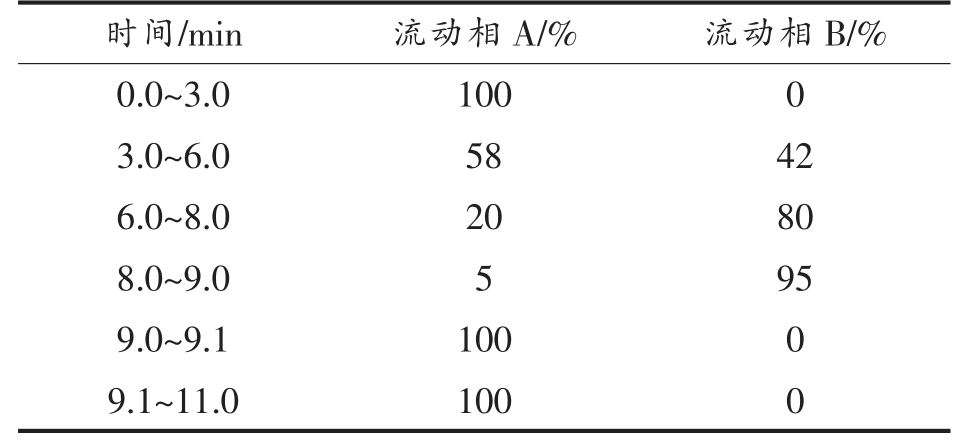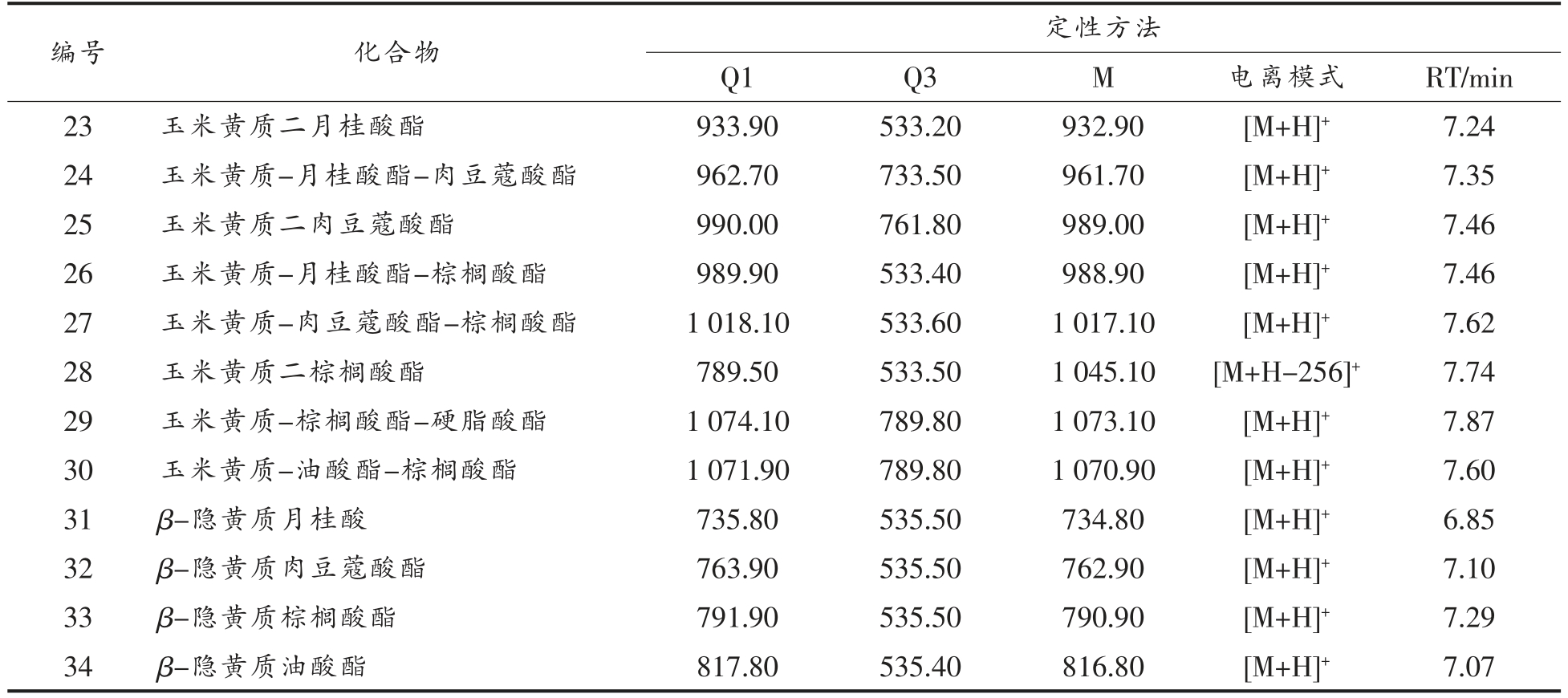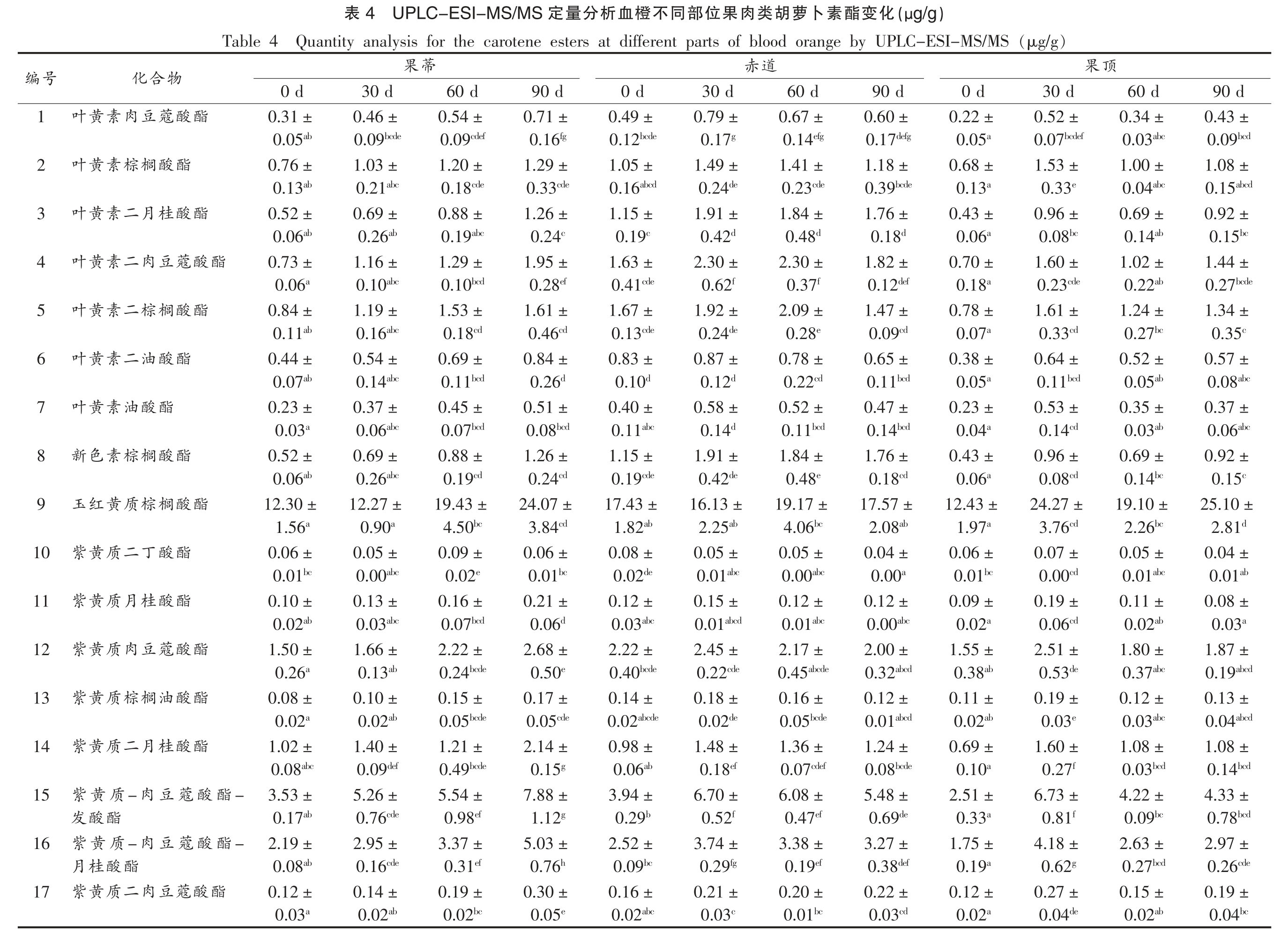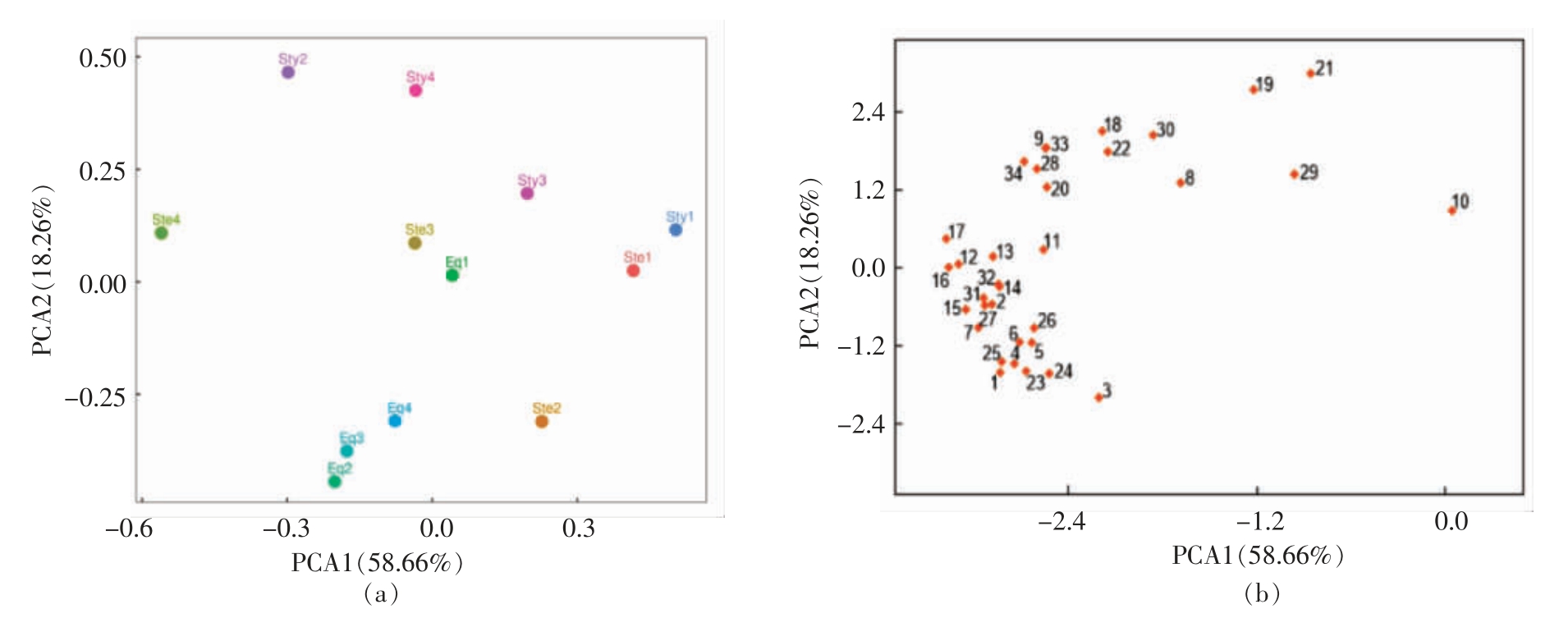血橙(Citrus sinensis L. Osbeck) 属于甜橙类,塔罗科血橙为其常见的血橙品种之一,其果肉呈红色血丝或血斑状,具有特有的玫瑰香气[1-3]。近年来,血橙因富含花青素、类胡萝卜素、抗坏血酸、多酚等天然活性物质,且肉质细软、化渣性好而备受消费者青睐[4-6]。脂溶性类胡萝卜素和水溶性花青素是柑橘类水果中2 种主要的红色色素[3,7-8]。其中,类胡萝卜素属于萜类化合物[9],镶嵌于叶绿体和有色体内,其种类繁多,且每年会有新的类胡萝卜素被发现[10-11]。类胡萝卜素的合成受复杂因素的影响,如温、湿度等外界条件[12-13]。类胡萝卜素的稳定性差,在光、热、酸等外界条件作用下可发生氧化、异构等[14],如脐橙果皮和果肉中的类胡萝卜素含量受贮藏温度的影响,且存在明显的组织特异性[15]。目前人体无法合成类胡萝卜素,只能依靠饮食摄入,其具有抗氧化、降血脂、抗肿瘤、抗慢病、增强免疫力等多方面潜在功效[16-17]。近年来,类胡萝卜素的多样性组成引起人们的广泛关注。
血橙果肉的着色属于低温依赖型[18-20],目前鲜有关于长时低温贮藏对血橙不同部位果肉中类胡萝卜素酯变化的研究。鉴于此,本研究以不同低温贮藏期血橙不同部位的果肉为研究对象,采用常用代谢物检测方法UPLC-API-Q TRAP-MS/MS(超高效液相色谱-大气压化学离子源-三重四极杆-线性离子阱质谱,简称超高效液相色谱-串联三重四极杆质谱法),系统分析血橙中类胡萝卜素酯的种类和含量变化,为解析低温贮藏血橙果肉中类胡萝卜素酯的多样性组成及其变化提供试验参考。
1 材料与方法
1.1 材料与试剂
塔罗科血橙 (Citrus sinensis L.Osbeck),重庆江津锦橙实业有限公司。选择45 个无病虫害的健康果实作为样品(生物学重复3 次),分别贮藏0,30,60,90 d(贮藏温度9 ℃,相对湿度85%),去皮处理后分别沿着果实横切面赤道左右8 mm 切分,即得到果蒂、赤道和果顶处果肉,立即于-80℃保存,备用。
甲醇、乙腈、乙醇、甲基叔丁基醚均为色谱纯级,德国Merck 公司;化合物标准品(色谱纯级),美国Sigma-Aldrich 和捷克共和国Olchemim 公司。
1.2 仪器与设备
FD-1A-80 冷冻干燥机,江苏恒敏仪器制造有限公司;MM400 Retsch 研磨仪,德国莱驰公司;ExionLCTM AD 超高校液相色谱仪(UPLC)和Applied Biosystems 6500 Quadrupole Trap 串联质谱仪(MS/MS),美国ABSCIEX 公司。
1.3 方法
1.3.1 UPLC-API-MS/MS 样品前处理 参考Geyer 等[21-23]的方法并加以修改。将血橙冻干样品用研磨仪在30 Hz 条件下研磨1 min 至粉末。取50 mg 粉末样品,分别加入800 μL 正己烷∶丙酮∶乙醇混合提取液(体积比1∶2∶2)和200 μL 蒸馏水,取混合溶液500 μL (含0.01%二叔丁基对甲酚,g/mL)涡旋提取20 min 后12 000 r/min 条件下离心5 min,取上清液。重复提取4 次后合并上清液,浓缩至干。浓缩后的样品用100 μL 甲醇∶甲基叔丁基醚混合复溶溶液 (体积比1∶1) 进行复溶后,再加入同体积复溶液的蒸馏水,振荡混匀后于4 ℃,12 000 r/min 条件下离心5 min。将上清液样品过0.22 μm 滤膜后,保存于棕色进样瓶中,以待LC-MS/MS 分析。
1.3.2 UPLC-API-MS/MS 条件
1.3.2.1 UPLC 条件 参考Geyer 等[21-23]的方法并加以修改。YMC C30 色谱柱 (2 mm×100 mm×3 μm);流速0.8 mL/min;柱温28 ℃;进样量2 μL。以甲醇∶乙腈(体积比3∶1)且加入0.01%BHT 和0.1%甲酸的混合液为流动相A,以甲基叔丁基醚(含0.01%BHT)为流动相B,以甲醇为洗针液。利用梯度洗脱进行UPLC 分析,程序见表1。
表1 液相色谱梯度洗脱条件
Table 1 Liquid chromatography gradient elution conditions

?
1.3.2.2 API-MS/MS 条件 参考Geyer 等[21-23]的方法并加以修改。API6500 Q TRAP LC/MS/MS 系统配置一个涡轮离子喷雾接口,在正离子模式下运行,并由Analyst 1.6.3 软件(AB Sciex)控制。APCI 源操作参数如下:离子源APCI+;源温度350℃;帘气(CUR)25.0 psi;碰撞气(CAD)中等。优化射入电压(DP)和碰撞电压(CE),确定各多反应监测模式(MRM)离子对的DP 和CE 参数。根据在此期间洗脱的类胡萝卜素酯,对每个时期特定的一组MRM 离子对进行检测。
1.3.3 血橙果肉类胡萝卜素酯的定性和定量分析 基于类胡萝卜素酯标准品对血橙果肉类胡萝卜素酯进行定性分析。借助三重四极杆质谱的多反应监测模式(MRM)分析血橙果肉中类胡萝卜素酯,在该模式下,目标物质前体离子即母离子的筛选由四极杆完成,以排除其它分子质量物质对应的离子,初步排除干扰。经碰撞室诱导电离后,前体离子断裂,碎片离子形成。特征碎片离子由三重四极杆过滤选出,以排除非目标离子,进一步排除干扰,保证定量的精确性和重复性。不同样品类胡萝卜素质谱分析数据获取后,对所有的类胡萝卜素色谱峰峰面积积分,并对其中同一物质在不同样本中的色谱峰进行积分校正;利用软件Analyst1.6.3 处理质谱数据,采用标准曲线方程计算各化学成分的含量(以μg/g 鲜重计)。
1.4 数据分析与处理
应用IBM SPSS Statistics 22.0 软件对试验数据进行分析,采用邓肯多重比较进行差异分析,其中,P<0.05 表示差异显著。利用R 语言(含vegan包2.5.4,stats 包3.5.0 和ggplot2 包3.2.0) 进行多变量主成分分析;运用Graphpad Prism 7.0、Photoshop 软件绘图。
2 结果与分析
2.1 血橙果肉类胡萝卜素酯的鉴定
血橙不同部位果肉中类胡萝卜素酯成分由UPLC-API-Q TRAP-MS/MS 分析完成,根据类胡萝卜素酯保留时间与离子对的信息,对每种类胡萝卜素在不同样本中检测到的质谱峰进行校正,以确保定性、定量的准确。质谱数据则由Analyst 1.6.3 软件处理。图1为血橙果肉中类胡萝卜素酯各组分总离子流图(Total ions current,TIC)。

图1 血橙果肉中类胡萝卜素酯各组分总离子流图
Fig.1 Total ion current chromatograms of components for carotene esters of blood orange pulp
对血橙果肉中类胡萝卜素酯的定性分析结果见表2,共发现34 种类胡萝卜素酯,包括7 种叶黄素酯,1 种新色素棕榈酸酯,1 种玉红黄质棕榈酸酯,12 种紫黄质酯,9 种玉米黄质酯以及4 种β-隐黄质酯。
表2 UPLC-ESI-MS/MS 定性分析血橙果肉类胡萝卜素酯
Table 2 Identification of the carotene esters of blood orange by UPLC-ESI-MS/MS

编号 化合物 定性方法Q1 Q3 M 电离模式 RT/min 1 叶黄素肉豆蔻酸酯 761.80 533.50 778.80 [M+H-18]+ 6.56 2 叶黄素棕榈酸酯 789.80 533.50 806.80 [M+H-18]+ 6.82 3 叶黄素二月桂酸酯 733.50 533.30 933.50 [M+H-201]+ 7.10 4 叶黄素二肉豆蔻酸酯 761.80 533.50 988.80 [M+H-228]+ 7.30 5 叶黄素二棕榈酸酯 789.80 533.50 1 044.80 [M+H-256]+ 7.40 6 叶黄素二油酸酯 815.70 533.40 1 096.70 [M+H-282]+ 7.19 7 叶黄素油酸酯 815.70 533.40 832.70 [M+H-18]+ 6.40 8 新色素棕榈酸酯 821.70 565.50 838.70 [M+H-18]+ 6.40 9 玉红黄质棕榈酸酯 791.70 535.40 790.70 [M+H]+ 7.27 10 紫黄质二丁酸酯 741.60 653.50 740.60 [M+H]+ 6.09 11 紫黄质月桂酸酯 783.70 583.40 800.70 [M+H-18]+ 5.60 12 紫黄质肉豆蔻酸酯 811.80 793.70 810.80 [M+H]+ 5.95 13 紫黄质棕榈油酸酯 837.70 745.60 836.70 [M+H]+ 5.78 14 紫黄质二月桂酸酯 966.70 948.80 965.70 [M+H]+ 6.54 15 紫黄质-肉豆蔻酸酯-发酸酯 965.70 947.80 964.70 [M+H]+ 6.69 16 紫黄质-肉豆蔻酸酯-月桂酸酯 993.80 975.70 992.80 [M+H]+ 6.70 17 紫黄质二肉豆蔻酸酯 1 021.80 793.70 1 020.80 [M+H]+ 6.94 18 紫黄质-肉豆蔻酸酯-棕榈酸酯 1 050.00 793.80 1 049.00 [M+H]+ 7.10 19 紫黄质二棕榈酸酯 1 077.90 821.70 1 076.90 [M+H]+ 7.22 20 紫黄质-肉豆蔻酸酯-油酸酯 1 075.90 847.70 1 074.90 [M+H]+ 6.95 21 紫黄质二油酸酯 1 129.90 829.80 1 128.90 [M+H]+ 6.90 22 玉米黄质棕榈酸酯 807.80 551.50 806.80 [M+H]+ 6.88
(续表2)

注:Q1.母离子;Q3.特征碎片离子;M.相对分子质量;RT.保留时间,与标准品核对一致。
编号 化合物 定性方法Q1 Q3 M 电离模式 RT/min 23 玉米黄质二月桂酸酯 933.90 533.20 932.90 [M+H]+ 7.24 24 玉米黄质-月桂酸酯-肉豆蔻酸酯 962.70 733.50 961.70 [M+H]+ 7.35 25 玉米黄质二肉豆蔻酸酯 990.00 761.80 989.00 [M+H]+ 7.46 26 玉米黄质-月桂酸酯-棕榈酸酯 989.90 533.40 988.90 [M+H]+ 7.46 27 玉米黄质-肉豆蔻酸酯-棕榈酸酯 1 018.10 533.60 1 017.10 [M+H]+ 7.62 28 玉米黄质二棕榈酸酯 789.50 533.50 1 045.10 [M+H-256]+ 7.74 29 玉米黄质-棕榈酸酯-硬脂酸酯 1 074.10 789.80 1 073.10 [M+H]+ 7.87 30 玉米黄质-油酸酯-棕榈酸酯 1 071.90 789.80 1 070.90 [M+H]+ 7.60 31 β-隐黄质月桂酸 735.80 535.50 734.80 [M+H]+ 6.85 32 β-隐黄质肉豆蔻酸酯 763.90 535.50 762.90 [M+H]+ 7.10 33 β-隐黄质棕榈酸酯 791.90 535.50 790.90 [M+H]+ 7.29 34 β-隐黄质油酸酯 817.80 535.40 816.80 [M+H]+ 7.07
2.2 血橙不同部位果肉类胡萝卜素酯变化的定量分析
配制不同浓度的类胡萝卜素标准品溶液,获取各浓度标准品溶液的质谱峰强度数据,计算不同类胡萝卜素酯的标准曲线方程及相关系数,见表3。
表3 类胡萝卜素酯标准品标准曲线
Table 3 Calibration equations of authentic standard for the carotene esters

编号 化合物 定量方法标准曲线方程 R2叶黄素肉豆蔻酸酯 y=0.93282x+0.00463 0.9989 2叶黄素棕榈酸酯 y=0.93282x+0.00463 0.9989 3叶黄素二月桂酸酯 y=0.93282x+0.00463 0.9989 4叶黄素二肉豆蔻酸酯 y=0.93282x+0.00463 0.9989 5叶黄素二棕榈酸酯 y=0.93282x+0.00463 0.9989 6叶黄素二油酸酯 y=0.93282x+0.00463 0.9989 7叶黄素油酸酯 y=0.93282x+0.00463 0.9989 8新色素棕榈酸酯 y=2.48212x-0.00832 0.9981 9玉红黄质棕榈酸酯 y=0.62746x+0.00604 0.9982 10 紫黄质二丁酸酯 y=3.18240x+0.00744 0.9951 11 紫黄质月桂酸酯 y=3.18240x+0.00744 0.9951 12 紫黄质肉豆蔻酸酯 y=3.18240x+0.00744 0.9951 13 紫黄质棕榈油酸酯 y=3.18240x+0.00744 0.9951 14 紫黄质二月桂酸酯 y=3.18240x+0.00744 0.9951 15 紫黄质-肉豆蔻酸酯-发酸酯 y=3.18240x+0.00744 0.9951 16 紫黄质-肉豆蔻酸酯-月桂酸酯 y=3.18240x+0.00744 0.9951 17 紫黄质二肉豆蔻酸酯 y=3.18240x+0.00744 0.9951 18 紫黄质-肉豆蔻酸酯-棕榈酸酯 y=3.18240x+0.00744 0.9951 19 紫黄质二棕榈酸酯 y=3.18240x+0.00744 0.9951 20 紫黄质-肉豆蔻酸酯-油酸酯 y=3.18240x+0.00744 0.9951 21 紫黄质二油酸酯 y=3.18240x+0.00744 0.9951 1
(续表3)

编号 化合物 定量方法标准曲线方程 R2 22 玉米黄质棕榈酸酯 y=0.19619x+0.00601 0.9975 23 玉米黄质二月桂酸酯 y=0.19619x+0.00601 0.9975 24 玉米黄质-月桂酸酯-肉豆蔻酸酯 y=0.19619x+0.00601 0.9975 25 玉米黄质二肉豆蔻酸酯 y=0.19619x+0.00601 0.9975 26 玉米黄质-月桂酸酯-棕榈酸酯 y=0.19619x+0.00601 0.9975 27 玉米黄质-肉豆蔻酸酯-棕榈酸酯 y=0.19619x+0.00601 0.9975 28 玉米黄质二棕榈酸酯 y=0.46422x+0.00213 0.9928 29 玉米黄质-棕榈酸酯-硬脂酸酯 y=0.19619x+0.00601 0.9975 30 玉米黄质-油酸酯-棕榈酸酯 y=0.19619x+0.00601 0.9975 31 β-隐黄质月桂酸 y=0.34505x+0.00352 0.9972 32 β-隐黄质肉豆蔻酸酯 y=0.34505x+0.00352 0.9972 33 β-隐黄质棕榈酸酯 y=0.34505x+0.00352 0.9972 34 β-隐黄质油酸酯 y=0.34505x+0.00352 0.9972
基于积分峰面积和标准曲线方程对34 种血橙果肉类胡萝卜素酯进行定量分析,如表4分析结果所示,玉红黄质棕榈酸酯和β-隐黄质棕榈酸酯在果蒂、赤道和果顶中含量均最高,其次是β-隐黄质油酸酯、β-隐黄质肉豆蔻酸酯和β-隐黄质月桂酸。此外,新鲜采摘的血橙赤道中玉红黄质棕榈酸酯、β-隐黄质棕榈酸酯、β-隐黄质油酸酯、β-隐黄质肉豆蔻酸酯和β-隐黄质月桂酸的含量均高于果蒂和果顶。果蒂中叶黄素肉豆蔻酸酯、叶黄素棕榈酸酯、叶黄素二月桂酸酯、叶黄素二肉豆蔻酸酯、叶黄素二棕榈酸酯、叶黄素二油酸酯、叶黄素油酸酯、新色素棕榈酸酯、玉红黄质棕榈酸酯、紫黄质月桂酸酯、紫黄质肉豆蔻酸酯、紫黄质棕榈油酸酯、紫黄质二月桂酸酯、紫黄质-肉豆蔻酸酯-发酸酯、紫黄质-肉豆蔻酸酯-月桂酸酯、紫黄质二肉豆蔻酸酯、β-隐黄质月桂酸、β-隐黄质肉豆蔻酸酯、β-隐黄质棕榈酸酯及β-隐黄质油酸酯的含量随低温贮藏时间的延长而呈上升趋势,且0 d 和90 d 组间存在显著性差异。低温贮藏期间,赤道和果顶中类胡萝卜素酯含量变化不明显,且2 个部位果肉中类胡萝卜素酯含量在不同贮藏时间组间无显著性差异。

90 d 0.43±bcd 0.09 1.08±abcd 0.15 0.92±bc 0.15 1.44±bcde 0.27 1.34±c 0.35 0.57±abc 0.08 0.37±abc 0.06 0.92±c 0.15 25.10±d 2.81 0.04±ab 0.01 0.08±a 0.03 1.87±abcd 0.19 0.13±abcd 0.04 1.08±bcd 0.14 4.33±bcd 0.78 2.97±cde 0.26 0.19±bc 0.04顶60 d 0.34±abc 0.03 1.00±abc 0.04 0.69±ab 0.14 1.02±ab 0.22 1.24±bc 0.27 0.52±ab 0.05 0.35±ab 0.03 0.69±bc 0.14 19.10±bc 2.26 0.05±abc 0.01 0.11±ab 0.02 1.80±abc 0.37 0.12±abc 0.03 1.08±bcd 0.03 4.22±bc 0.09 2.63±bcd 0.27 0.15±ab 0.02(μg/g)化变酯素卜萝胡类肉果位部同不橙血析分量UPLC-ESI-MS/MS 定4表Quantity analysis for the carotene esters at different parts of blood orange by UPLC-ESI-MS/MS (μg/g)Table 4 果道赤蒂果物合化30 d 0 d 90 d 60 d 30 d 0 d 90 d 60 d 30 d 0 d 0.52±0.22±0.60±0.67±0.79±0.49±0.71±0.54±0.46±0.31±酯酸蔻豆肉素黄bcdef 0.07 a 0.05 defg 0.17 efg 0.14 g 0.17 bcde 0.12 fg 0.16 cdef 0.09 bcde 0.09 ab 0.05 1.53±0.68±1.18±1.41±1.49±1.05±1.29±1.20±1.03±0.76±酯酸榈棕素黄e 0.33 a 0.13 bcde 0.39 cde 0.23 de 0.24 abcd 0.16 cde 0.33 cde 0.18 abc 0.21 ab 0.13 0.96±0.43±1.76±1.84±1.91±1.15±1.26±0.88±0.69±0.52±酯酸桂月二素黄bc 0.08 a 0.06 d 0.18 d 0.48 d 0.42 c 0.19 c 0.24 abc 0.19 ab 0.26 ab 0.06 1.60±0.70±1.82±2.30±2.30±1.63±1.95±1.29±1.16±0.73±酯酸蔻豆肉二素黄cde 0.23 a 0.18 def 0.12 f 0.37 f 0.62 cde 0.41 ef 0.28 bcd 0.10 abc 0.10 a 0.06 1.61±0.78±1.47±2.09±1.92±1.67±1.61±1.53±1.19±0.84±酯酸榈棕二素黄cd 0.33 a 0.07 cd 0.09 e 0.28 de 0.24 cde 0.13 cd 0.46 cd 0.18 abc 0.16 ab 0.11 0.64±0.38±0.65±0.78±0.87±0.83±0.84±0.69±0.54±0.44±酯酸油二素黄bcd 0.11 a 0.05 bcd 0.11 cd 0.22 d 0.12 d 0.10 d 0.26 bcd 0.11 abc 0.14 ab 0.07 0.53±0.23±0.47±0.52±0.58±0.40±0.51±0.45±0.37±0.23±酯酸油素黄cd 0.14 a 0.04 bcd 0.14 bcd 0.11 d 0.14 abc 0.11 bcd 0.08 bcd 0.07 abc 0.06 a 0.03 0.96±0.43±1.76±1.84±1.91±1.15±1.26±0.88±0.69±0.52±酯酸榈棕素色cd 0.08 a 0.06 cd 0.18 e 0.48 de 0.42 cde 0.19 cd 0.24 cd 0.19 abc 0.26 ab 0.06 24.27±12.43±17.57±19.17±16.13±17.43±24.07±19.43±12.27±12.30±酯酸榈棕质黄红cd 3.76 a 1.97 ab 2.08 bc 4.06 ab 2.25 ab 1.82 cd 3.84 bc 4.50 a 0.90 a 1.56 0.07±0.06±0.04±0.05±0.05±0.08±0.06±0.09±0.05±0.06±酯酸丁二质黄cd 0.00 bc 0.01 a 0.00 abc 0.00 abc 0.01 de 0.02 bc 0.01 e 0.02 abc 0.00 bc 0.01 0.19±0.09±0.12±0.12±0.15±0.12±0.21±0.16±0.13±0.10±酯酸桂月质黄cd 0.06 a 0.02 abc 0.00 abc 0.01 abcd 0.01 abc 0.03 d 0.06 bcd 0.07 abc 0.03 ab 0.02 2.51±1.55±2.00±2.17±2.45±2.22±2.68±2.22±1.66±1.50±酯酸蔻豆肉质黄de 0.53 ab 0.38 abcd 0.32 abcde 0.45 cde 0.22 bcde 0.40 e 0.50 bcde 0.24 ab 0.13 a 0.26 0.19±0.11±0.12±0.16±0.18±0.14±0.17±0.15±0.10±0.08±酯酸油榈棕质黄e 0.03 ab 0.02 abcd 0.01 bcde 0.05 de 0.02 abcde 0.02 cde 0.05 bcde 0.05 ab 0.02 a 0.02 1.60±0.69±1.24±1.36±1.48±0.98±2.14±1.21±1.40±1.02±酯酸桂月二质黄f 0.27 a 0.10 bcde 0.08 cdef 0.07 ef 0.18 ab 0.06 g 0.15 bcde 0.49 def 0.09 abc 0.08 6.73±2.51±5.48±6.08±6.70±3.94±7.88±5.54±5.26±3.53±-酯酸蔻豆-肉质黄f 0.81 a 0.33 de 0.69 ef 0.47 f 0.52 b 0.29 g 1.12 ef 0.98 cde 0.76 ab 0.17酯酸4.18±1.75±3.27±3.38±3.74±2.52±5.03±3.37±2.95±2.19±-酯酸蔻豆肉-质黄g 0.62 a 0.19 def 0.38 ef 0.19 fg 0.29 bc 0.09 h 0.76 ef 0.31 cde 0.16 ab 0.08酯酸桂0.27±0.12±0.22±0.20±0.21±0.16±0.30±0.19±0.14±0.12±酯酸蔻豆肉二质黄de 0.04 a 0.02 cd 0.03 bc 0.01 c 0.03 abc 0.02 e 0.05 bc 0.02 ab 0.02 a 0.03叶叶叶叶叶叶叶新玉紫紫紫紫紫紫发紫月紫号编1 2 3 4 5 6 7 8 9 10 11 12 13 14 15 16 17

90 d 0.12±cde 0.00 0.20±d 0.10 0.05±bc 0.01 0.04±de 0.01 0.85±cd 0.20 0.13±abcd 0.07 0.02±abc 0.03 0.75±bc 0.11 0.41±abc 0.08 0.38±bcde 0.05 0.90±abc 0.09 0.05±d 0.04 1.03±bcde 0.09 13.60±d 1.71 13.60±cd 2.51 48.30±e 6.52 18.23±ef 3.57顶果60 d 30 d 0.09±0.13±abcd 0.03 de 0.04 0.18±0.18±bc 0.03 bc 0.00 0.03±0.07±ab 0.01 c 0.02 0.03±0.04±bcd 0.01 e 0.01 0.52±0.79±ab 0.13 bc 0.15 0.09±0.11±abc 0.05 abcd 0.02 0.00±0.01±ab 0.00 abc 0.01 0.55±0.75±ab 0.07 bc 0.16 0.39±0.46±abc 0.05 bcd 0.06 0.29±0.41±ab 0.06 bcde 0.04 0.88±0.99±abc 0.06 d 0.17 0.01±0.04±ab 0.01 bc 0.02 0.86±1.11±abcd 0.09 de 0.15 8.37±13.10±c 1.02 d 2.48 7.04±11.47±ab 0.93 c 1.27 36.17±46.50±c 3.43 de 4.54 13.67±18.57±cd 1.46 ef 1.76 0 d 90 d 0.08±0.09±abc 0.03 abcd 0.03 0.13±0.11±ab 0.03 ab 0.07 0.03±0.04±a 0.01 ab 0.01 0.03±0.02±bcd 0.00 ab 0.00 0.42±0.47±a 0.19 ab 0.13 0.00±0.25±a 0.00 de 0.09 0.00±0.04±a 0.00 bc 0.05 0.36±1.17±a 0.08 de 0.17 0.23±0.59±a 0.07 cd 0.09 0.21±0.45±a 0.06 cde 0.05 0.61±0.80±a 0.05 abc 0.25 0.00±0.02±a 0.00 ab 0.01 0.78±0.68±ab 0.21 a 0.07 4.08±18.07±a 0.38 e 2.98 4.33±14.73±a 0.20 d 1.82 24.13±34.00±ab 3.35 c 2.10 9.39±14.47±abc 1.74 de 2.78道赤60 d 30 d 0.06±0.09±a 0.01 abcd 0.00 0.11±0.11±ab 0.03 ab 0.03 0.04±0.04±ab 0.01 ab 0.00 0.01±0.02±a 0.00 ab 0.01 0.53±0.55±ab 0.13 abc 0.18 0.24±0.25±cde 0.12 cde 0.05 0.04±0.04±bc 0.02 abc 0.03 1.43±1.39±e 0.27 e 0.36 0.52±0.60±bcd 0.05 cd 0.19 0.51±0.42±e 0.11 bcde 0.10 0.88±0.75±abc 0.20 abc 0.18 0.02±0.01±ab 0.02 a 0.01 0.96±0.69±abcde 0.24 a 0.02 14.80±13.90±d 2.07 d 2.49 13.10±11.50±cd 2.52 c 1.78 36.40±30.63±c 8.86 abc 3.73 13.57±11.63±cd 2.72 abcd 1.89 0 d 0.11±bcde 0.01 0.11±ab 0.01 0.03±ab 0.00 0.02±bc 0.01 0.68±abc 0.20 0.13±abcd 0.06 0.00±ab 0.00 0.80±bc 0.20 0.63±d 0.19 0.47±de 0.07 0.83±abc 0.18 0.00±a 0.00 1.07±cde 0.11 7.04±abc 0.66 7.68±b 1.26 33.40±bc 4.07 12.77±bcd 1.93蒂果90 d 60 d 30 d 0.15±0.11±0.07±e 0.03 abcde 0.03 ab 0.01 0.17±0.15±0.07±bc 0.03 bc 0.01 a 0.00 0.07±0.03±0.04±c 0.01 a 0.01 ab 0.01 0.03±0.02±0.01±cde 0.01 ab 0.00 a 0.00 1.11±0.75±0.49±d 0.26 bc 0.21 ab 0.05 0.34±0.13±0.17±e 0.18 abcd 0.06 bcd 0.06 0.06±0.02±0.03±c 0.01 abc 0.02 abc 0.03 1.76±0.99±0.72±f 0.27 cd 0.16 bc 0.10 0.91±0.53±0.55±e 0.06 bcd 0.15 bcd 0.09 0.66±0.42±0.35±f 0.13 bcde 0.03 bcd 0.05 1.01±0.92±0.70±d 0.12 bc 0.12 ab 0.12 0.00±0.00±0.00±a 0.00 a 0.00 a 0.00 1.22±1.09±0.73±e 0.23 cde 0.21 a 0.06 20.33±9.21±7.64±e 2.94 c 1.73 bc 0.99 14.60±8.25±6.33±d 2.26 b 1.92 ab 0.14 46.40±37.87±23.17±de 7.77 cd 7.20 a 3.31 20.23±12.31±8.52±f 4.67 abcd 2.81 ab 0.86)。(P<0.05义意学计统有异差示表母0 d 0.08±abc 0.00 0.12±ab 0.03 0.03±ab 0.01 0.02±ab 0.00 0.66±abc 0.09 0.07±ab 0.02 0.00±a 0.00 0.49±ab 0.05 0.36±ab 0.07 0.31±abc 0.07 0.75±abc 0.12 0.00±a 0.00 0.81±abc 0.12 4.71±ab 0.53 4.38±a 0.44 22.43±a 2.91 7.94±a 1.07字标肩同不)4表(续物合化号编-酯酸蔻豆肉-质黄紫18酯酸榈棕酯酸榈棕二质黄紫19-酯酸蔻豆肉-质黄紫20酯酸油酯酸油二质黄紫21酯酸榈棕质黄米玉22酯酸桂月二质黄米玉23-酯酸桂月-质黄米玉24酯酸蔻豆肉酸蔻豆肉二质黄米玉25酯-酯酸桂月-质黄米玉26酯酸榈棕酸蔻豆肉-质黄米玉27酯酸榈-棕酯酯酸榈棕二质黄米玉28-酯酸榈棕-质黄米玉29酯酸脂硬-棕酯酸-油质黄米玉30酯酸榈酸桂月质黄隐β-31酯酸蔻豆肉质黄β-隐32酯酸榈棕质黄隐β-33酯酸油质黄β-隐34行一”;同差准标±值均“平为值数中:表注
2.3 血橙不同部位果肉类胡萝卜素酯主成分分析
主成分分析方法(PCA)用于分析低温贮藏期血橙不同部位果肉中类胡萝卜素酯的变化特征,分析结果显示4 个主成分贡献总方差的91.88%,如图2a 所示,PC1 和PC2 分别贡献总方差的58.66%和18.26%。由图可知,低温贮藏0 d 和30 d 果蒂样品(即Ste1 和Ste2)、低温贮藏0 d 和60 d果顶样品(Sty1 和Sty3)位于右上部分,低温冷藏0 d 赤道样品(即Eq1) 位于右下部分,表明Ste1、Ste2、Sty1、Sty3 和Eq1 与PC1 呈正相关,果蒂低温贮藏60 d 和90 d(即Ste3 和Ste4)以及果顶低温贮藏30 d 和90 d 样品(即Sty2 和Sty4)位于左上部分,赤道低温贮藏30,60 d 和90 d 样品(即分别为Eq2、Eq3、Eq4)位于左下部分,表明Ste3、Ste4、Eq2、Eq3、Eq4、Sty2 和Sty4 与PC1 呈负相关。此外,Ste1、Ste3、Ste4、Sty1、Sty2、Sty3、Sty4 以 及Eq1与PC2 呈正相关,而Eq2、Eq3、Eq4 以及Ste2 与PC2 呈负相关。以上结果表明,不同低温贮藏期果蒂、果顶和赤道通过PCA 分析已完成分离并表现出差异显著性。从PC2 变量图(图2b)可知,新色素棕榈酸酯、玉红黄质棕榈酸酯、紫黄质酯(即紫黄质月桂酸酯、紫黄质肉豆蔻酸酯、紫黄质棕榈油酸酯、紫黄质二肉豆蔻酸酯、紫黄质-肉豆蔻酸酯-棕榈酸酯、紫黄质二棕榈酸酯、紫黄质-肉豆蔻酸酯-油酸酯、紫黄质二油酸酯)、玉米黄质酯(即玉米黄质棕榈酸酯、玉米黄质二棕榈酸酯、玉米黄质-棕榈酸酯-硬脂酸酯、玉米黄质-油酸酯-棕榈酸酯)、β-隐黄质酯 (即β-隐黄质棕榈酸酯、β-隐黄质油酸酯) 与PC2 呈正相关,且紫黄质月桂酸酯、紫黄质肉豆蔻酸酯、紫黄质棕榈油酸酯、紫黄质二肉豆蔻酸酯与Ste4 较为接近;新色素棕榈酸酯、玉红黄质棕榈酸酯、紫黄质-肉豆蔻酸酯-棕榈酸酯、紫黄质-肉豆蔻酸酯-油酸酯、玉米黄质棕榈酸酯、玉米黄质二棕榈酸酯、玉米黄质-油酸酯-棕榈酸酯、β-隐黄质棕榈酸酯、β-隐黄质油酸酯与Sty2 较为接近;紫黄质二棕榈酸酯、紫黄质二油酸酯与Sty4 较为接近;玉米黄质-棕榈酸酯-硬脂酸酯与Ste3 较为接近。紫黄质二丁酸酯与PC1 呈正相关,且与Ste1、Eq1、Sty1、Sty3 较为接近。以上结果表明,除叶黄素酯外,不同贮藏期血橙不同部位果肉中的绝大多数酯类(如新色素棕榈酸酯、玉红黄质棕榈酸酯、紫黄质酯、玉米黄质酯、β-隐黄质酯)发生了主要变化。

图2 血橙不同部位果肉类胡萝卜素酯主成分分析
Fig.2 PCA of components for carotene esters at different parts of blood orange pulp
注:低温贮藏0 d 的血橙果蒂、赤道和果顶样品分别为Ste1、Eq1、Sty1;低温贮藏30 d 的血橙果蒂、赤道和果顶样品分别为Ste2、Eq2、Sty2;低温贮藏60 d 的血橙果蒂、赤道和果顶样品分别为Ste3、Eq3、Sty3;低温贮藏90 d 的血橙果蒂、赤道和果顶样品分别为Ste4、Eq4、Sty4。
3 结论
本研究利用UPLC-API-Q TRAP-MS/MS 对低温贮藏期血橙不同部位果肉类胡萝卜素酯变化进行分析,分析结果显示在血橙果肉中共鉴定出34 种类胡萝卜素酯。基于外标法(标准曲线方程)对各类胡萝卜素酯含量进行定量分析,分析结果显示在血橙果蒂、赤道和果顶中含量最高的类胡萝卜素酯均为β-隐黄质棕榈酸酯和玉红黄质棕榈酸酯,其次是β-隐黄质油酸酯。此外,研究结果显示在低温贮藏过程中,血橙不同部位果肉类胡萝卜素酯含量发生改变,并且在果蒂中多种类胡萝卜素酯含量随冷藏时间的延长而呈现上升趋势。另外,主成分分析结果显示不同低温贮藏期果蒂、果顶和赤道的果肉中类胡萝卜素酯表现出显著性差异,且不同贮藏期血橙不同部位果肉中的绝大多数酯类(如新色素棕榈酸酯、玉红黄质棕榈酸酯、紫黄质酯、玉米黄质酯、β-隐黄质酯)发生了变化。已有研究显示,冷藏可能导致柑橘类水果非挥发性成分的变化[18-19,24],而果蒂中类胡萝卜素酯在冷藏过程中的显著增加可能与代谢相关酶的冷依赖性激活有关。本研究系统分析了不同低温贮藏时间对血橙不同部位果肉类胡萝卜素酯组成及含量的影响,为血橙营养价值研究提供参考。
[1]LI L,BIRCH K,BOESCH C.Effects of blood orange juice consumption on vascular function in healthy overweight subjects of European origin [J].Proceedings of the Nutrition Society,2018,77:E211.
[2]CEBADERA-MIRANDA L,DOMÍNGUEZ L,INÊSDIAS M,et al.Sanguinello and Tarocco (Citrus sinensis(L.) Osbeck):Bioactive compounds and colour appearance of blood oranges[J].Food Chemistry,2019,270:395-402.
[3]BARRECA D,GATTUSO G,LAGANÀ G,et al.C-and O-glycosyl flavonoids in Sanguinello and Tarocco blood orange (Citrus sinensis (L.) Osbeck)juice:Identification and influence on antioxidant properties and acetylcholinesterase activity[J].Food Chemistry,2016,196:619-627.
[4]曹少谦,潘思轶,姚晓琳,等.柱层析法分离纯化血橙花色苷[J].中国农业科学,2009,42(5):1728-1736.
CAO S Q,PAN S Y,YAO X L,et al.Isolation and purification of anthocyanins from blood oranges by column chromatography[J].Scientia Agricultura Sinica,2009,42(5):1728-1736.
[5]PANNITTERI C,CONTINELLA A,CICERO L,et al.Influence of postharvest treatments on qualitative and chemical parameters of Tarocco blood orange fruits to be used for fresh chilled juice[J].Food Chemistry,2017,230:441-447.
[6]喻最新.血橙花色苷积累规律与调控研究[D].重庆:西南大学,2019.
YU Z X.Biosynthesis and regulation of anthocyanin in the fruit of Citrus sinensis cv.Tarocco [D].Chongqing:Southwest University,2019.
[7]曹少谦,潘思轶.血橙花色苷研究进展[J].食品科学,2006,27(9):278-281.
CAO S Q,PAN S Y.Review of anthocyanins from blood orange[J].Food Science,2006,27(9):278-281.
[8]RAPISARDA P,BELLOMO S,INTRIGLIOLO F.Anthocyanins in blood orange:Composition and biological activity[J].In Recent Research Development in Agricultural and Food Chemistry,2001,5:217-230.
[9]孙明奇,潘思轶,胡建中,等.环境条件对柑橘果皮类胡萝卜素稳定性影响研究[J].食品科学,2008,29(6):127-129.
SUN M Q,PAN S Y,HU J Z,et al.Study on effect of environment on stability of citrus peel carotenoid[J].Food Science,2008,29(6):127-129.
[10]MAOKA T.Recent progress in structural studies of carotenoids in animals and plants[J].Archives of Biochemistry and Biophysics,2009,483(2):191-195.
[11]PETRY F,MERCADANTE A.Composition by LCMS/MS of new carotenoid esters in mango and Citrus[J].Journal of Agricultural and Food Chemistry,2016,64(43):8207-8224.
[12]GIULIANO G,TAVAZZA R,DIRETTO G,et al.Metabolic engineering of carotenoid biosynthesis in plants[J].Trends Biotechnol,2008,26(3):139-145.
[13]NISAR N,LI L,LU S,et al.Carotenoid metabolism in plants[J].Molecular Plant,2015,8(1):68-82.
[14]MAHALAKSHMI L,LEENA M,MOSES J,et al.Micro and nano encapsulation of β-carotene in zein protein:Size-dependent release and absorption behavior[J].Food & Function,2020,11(2):1647-1660.
[15]王长锋,陶能国,黄师荣.贮藏温度对红肉脐橙(Citrus sinensis Osbeck)果实类胡萝卜素含量的影响[J].食品科学,2013,34(4):255-260.
WANG C F,TAO N G,HUANG S R.Effect of storage temperature on carotenoid content of 'Cara Cara' navel orange (C.sinensis Osbeck)[J].Food Science,2013,34(4):255-260.
[16]BAHONAR A,SAADATNIA M,KHORVASH F,et al.Carotenoids as potential antioxidant agents in stroke prevention:A systematic review[J].International Journal of Preventive Medicine,2017,8(1):70.
[17]THORNE-LYMAN A,FAWZI W.Vitamin A and carotenoids during pregnancy and maternal,neonatal and infant health outcomes:A systematic review and meta-analysis[J].Paediatr Perinat Epidemiol,2012,26(S1):75-90.
[18]CARMONA L,ALQUÉZAR B,DIRETTO G,et al.Curing and low-temperature combined post-harvest storage enhances anthocyanin biosynthesis in blood oranges[J].Food Chemistry,2021,342:128334.
[19]CARMONA L,ALQUÉZAR B,MARQUES V,et al.Anthocyanin biosynthesis and accumulation in blood oranges during postharvest storage at different low temperatures[J].Food Chemistry,2017,237:7-14.
[20]BUTELLI E,LICCIARDELLO C,ZHANG Y,et al.Retrotransposons control fruit-specific,cold-dependent accumulation of anthocyanins in blood oranges[J].Plant Cell,2012,24(3):1242-1255.
[21]GEYER R,PEACOCK A,WHITE D,et al.Atmospheric pressure chemical ionization and atmospheric pressure photoionization for simultaneous mass spectrometric analysis of microbial respiratory ubiquinones and menaquinones[J].Journal of Mass Spectrometry,2004,39(8):922-929.
[22]INBARAJ B,LU H,HING C,et al.Determination of carotenoids and their esters in fruits of Lycium barbarum Linnaeus by HPLC-DAD-APCI-MS[J].Journal of Pharmaceutical and Biomedical Analysis,2008,47(4/5):812-818.
[23]PETRY F,MERCADANTE A.New method for carotenoid extraction and analysis by HPLC-DAD MS/MS in freeze-dried citrus and mango pulps[J].Journal of the Brazilian Chemical Society,2018,29(1):205-215.
[24]FABRONIA S,AMENTAA M,TIMPANAROA N,et al.Change in taste-altering non-volatile components of blood and common orange fruit during cold storage[J].Food Research International,2020,131:108916.